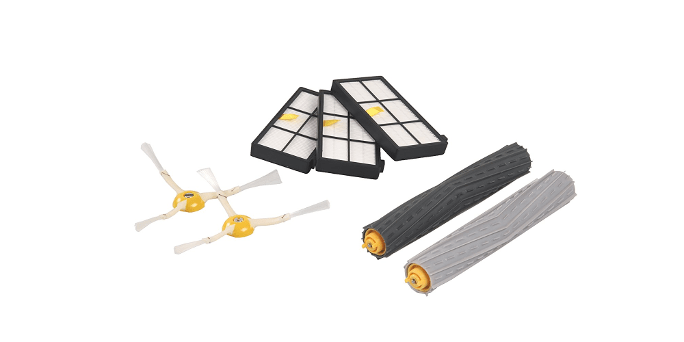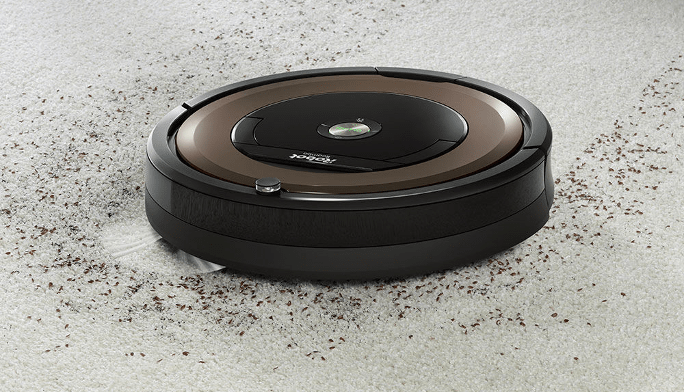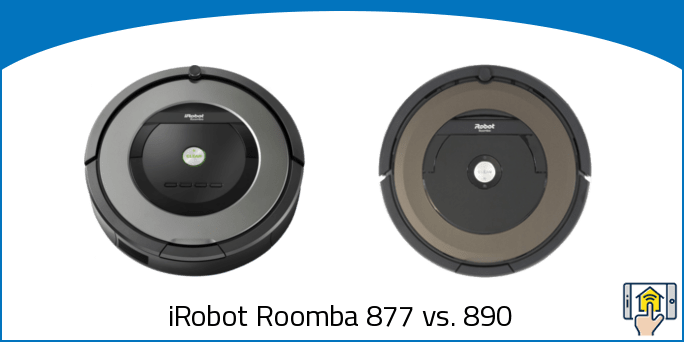Over the past few years, we’ve seen a surge of smart vacuums that promise to make taking care of your floors easier than ever before. But how do you sort through all the different models to figure out the best option for you? Roomba alone has built up quite the impressive lineup of robot vacuums over the last several years, with each model having its own benefits and drawbacks.
In this article we take a close look at the iRobot Roomba 877 vs. 890 — two excellent smart vacuums with a lot of similarities but also some notable differences. These vacuums both feature some of the excellent perks that come standard in the more premium 900 series, while still managing a more affordable price.
The 877 and 890 are incredibly similar in a lot of ways, but the latter has a significant advantage due to its WiFi connectivity. Let’s break down what each model has to offer so you can make the decision that’s right for you. While the 890 comes out on top with its extra internet-enabled features, the 877 certainly has its perks and could very well be the perfect fit for your home.
iRobot Roomba 877 vs. 890 — Things in Common
-
iAdapt – The underlying technology that powers both the Roomba 877 and 890 is known as iAdapt. This system essentially consists of two sensors that the vacuum uses in order to map out a room before it starts its cleaning.
The iAdapt technology is a significant advantage that newer models have when compared to their older counterparts, as it allows the Roomba to efficiently path through a room rather than just vacuuming randomly.
Your vacuum will also understand which areas need extra attention, and will double back on especially dirty sections in order to pick up each and every crumb. Suction power will also adjust dynamically based on the type of flooring the Roomba is cleaning — increasing power to work harder as it transitions to carpeting.
-
AeroForce High-Efficiency Filters – Vacuuming is a great way to keep your floors clean of debris, but the process of auctioning up debris can also potentially knock it up into the air. Fortunately, both the 877 and 890 feature AeroForce High-Efficiency filters that are able to trap 99% of particles as small as 10 microns in size.
While the AeroForce filters certainly do an excellent job of catching stray dirt and debris, we do wish that they featured the HEPA filters present on upgraded Roomba models that are capable of capturing microscopic particles as small as 0.3 microns in size. The filters on these vacuums will be sufficient enough for most situations, but for those especially sensitive to small particles like pollen, the lack of a HEPA filter may be noticeable.
-
Set Schedules – One of the best features of these Roomba smart vacuums is in their ability to run on a schedule. Through a remote control or the onboard buttons, you’ll be able to program your Roomba to clean at regular intervals up to seven times a week. The scheduling feature really allows you to set up your Roomba and forget about the hassle of vacuuming completely — allowing your new robot friend to do the heavy lifting.
-
3-Stage Cleaning – Both the 877 and the 890 take advantage of the same 3-stage cleaning process that has become the Roomba’s claim to fame.
First, the counter rotating brushes will lift dirt and debris from your floors. Afterwards, the second stage will brush along your wall in order to pick up any stray particles hanging around the baseboards. Last but certainly not least, the vacuum’s incredible suction will pull everything off the brushes and deposit them inside the dustbin.
-
Anti-Tangle Technology – Leaving your Roomba to handle the cleaning is a major perk, but can you really leave your vacuum to do its work unsupervised? Rooms are filled with all sorts of obstacles, including potential hazards like cords, carpet fringe, and tassels that could pose a problem for traditional vacuums.
However; the 877 and 890 both feature anti-tangle technology that ensures your robot won’t get stuck on cords or carpet. You should still do your best to ensure a clean path for your vacuum, but if you happen to miss a cord here or there you shouldn’t really have to worry.
-
Avoids Stairs – Your Roomba 878 or 890 is a significant investment, and the last thing you want is for it to take a tumble down the stairs. Fortunately, both models feature cliff-detect sensors that will keep the vacuum from falling off ledges, making either option a safe bet for cleaning on the second floor.
iRobot Roomba 877 vs. 890 — Differences

-
Difference #1: Remote Control – Let’s get started on the differences of the Roomba 877 vs. 890 — the first of which is the remote control.
Since the 877 doesn’t have WiFi capabilities, the main way you’ll control your vacuum is through a remote control. Using the remote, you can prompt your vacuum to start a cleaning and program a schedule. If there’s a particular spot that needs some extra attention outside of the scheduled cleanings, you can also easily call for a spot clean. The main downside of the remote control is that you’ll have to be within 15 feet of your vacuum to issue commands.
The 890, on the other hand, takes full advantage of its WiFi capabilities with control of the vacuum through the iHome app. This intuitive utility is available for both iOS and Android, and has a significant advantage over a traditional remote control due to its ability to control the vacuum from any range. As long as you can get online, you can adjust your Roomba’s settings or start a cleaning from work or even hundreds of miles away on vacation. It’s the perfect feature for making sure you come home to a clean house when you’re out and about on the go.
Ultimately, it’s clear that the 890 has the advantage with more flexible control options. With that said, if you don’t see yourself controlling your vacuum while you’re away from home, the 877’s remote has all the basic features covered.
-
Difference #2: Wall Barriers – While the 890 has the advantage in most every difference, the 877 actually comes ahead in the way it handles Wall Barriers.
The main utility of the Roomba comes in its ability to intelligently map out the layout of your house and thoroughly clean every inch of the room. However, there may be certain situations in which you wish to block your smart vacuum off from a specific area. This is where the idea of Wall Barriers come in, and the two models handle this dilemma in different ways.
The 877 uses an older technology known as a Virtual Wall Lighthouse. These node can be strategically placed near entryways or other areas you want left alone in order to block the Roomba from going through. However, these lighthouses are also capable of letting the Roomba pass into the next room once cleaning is complete. This aspect of the Lighthouses is especially useful, as it allows you to make sure an area is completely vacuumed before your Roomba moves on.
With the 890, iRobot actually took a step backward with the simpler Virtual Wall Barriers. These nodes do an excellent job of blocking a Roomba from entering a room, but they don’t have the ability to allow the Roomba entry once it has finished cleaning.
Ultimately, the 877 Barriers actually allow you more options. While the 890 Barriers might be a little bit easier to understand, there’s no denying that they traded out a useful feature for no good reason.
-
Difference #3: Battery Life – One area in which the Roomba 890 has a significant advantage is in its battery life. Simply put, you’ll get a much longer runtime on a single charge with the newer model — almost 100% longer, in fact!
This disparity is due to a different type of battery technology. The 877 and many Roomba models before it use a Nickel Metal Hydride battery that is capable of up to 65 minutes of runtime. This may be sufficient for small to medium-sized homes, but you’ll start to notice your Roomba heading back to its station for a charge before the cleaning is completed when tackling larger spaces.
The 890, on the other hand, uses the newer and more efficient Lithium-Ion battery. This battery allows for a runtime of 120 minutes on a single charge, which should ensure your Roomba has plenty of juice with which to finish your vacuuming.
It’s important to note that it’s rare that you’ll see the full 120 minute runtime in realistic vacuuming conditions. However, the Lithium-Ion technology is also capable of charging more quickly which gives it a clear advantage even if your Roomba isn’t always able to reach its full potential.
The bottom line: The 890’s superior battery technology put it head and shoulders above the 877.
-
Difference #4: Voice Control – One of the most noticeable advantage of having support for WiFi is the 890’s ability to support voice control with Alexa and Google Assistant.
Using your Amazon Echo or Google Home, you can easily start a cleaning or adjust the schedule using your voice alone.
Unfortunately, the 877 does not support this feature due to its inability to connect to the internet.
iRobot Roomba 877 vs. 890 — Comparison Chart
| iRobot Roomba 877 | iRobot Roomba 890 | |
|---|---|---|
| iAdapt | Yes | Yes |
| iRobot Home App | No | Yes |
| IR Remote Control | Yes | No |
| Recharge & Resume | No | No |
| Run Time | Up to 65 minutes | Up to 120 minutes |
| On-board Camera | No | No |
| Brushless Mechanism | Yes | Yes |
| Edge-Sweeping Brush | Yes | Yes |
| 3-Stage Cleaning System | AeroForce | 10x Suction |
| Carpet Boost Mode | No | No |
| Virtual Wall Barrier | No | Comes w/ 1 |
| Virtual Wall Lighthouses | Comes w/ 2 | No |
| Avoids Stairs | Yes | Yes |
| Cleaning Schedules | Yes | Yes |
| Coverage Maps | No | Yes |
| Voice Control | No | Alexa, Google Assistant |
| Diameter | 13.9 inches | 13.9 inches |
| Height | 3.6 inches | 3.6 inches |
| Weight | 8.4 lbs. | 8.4 lbs. |
iRobot Roomba 877 vs. 890 — Accessories

You shouldn’t really need much beyond the vacuums themselves to start the automated cleaning. With that said, there are some options available that make owning your Roomba a little more convenient — most focused entirely on maintenance.
Cleaning the floors day in and day out is bound to take its toll on your robot cleaner. Products like the allow you to keep your Roomba in tip-top-shape and puttering along for years to come.
To keep a crucial part of the 3-stage cleaning system running efficiently, consider purchasing the Roomba 800 and 900 Series Brush 3-Pack Kit. For an all-in-one replacement option for the parts that might start to see some wear, there’s also the Roomba 800 and 900 Series Replenishment Kit. With 3 filters, 2 side brushes, and a set of replacement extractors, you should be all set for maintenance for the foreseeable future.
Outside of products focused on maintenance, the other accessories worth mentioning are those that replace the battery to offer a longer battery life. We recommend the iRobot XLife Extended Life Battery or the Roomba 3300 Lithium Ion Battery for giving your vacuum that extra juice it needs to finish the job.
iRobot Roomba 877 vs. 890 — Our Thoughts

Ultimately, the comparison of the iRobot Roomba 877 vs. 890 is pretty cut and dry. By nearly every metric, the 890 is the super cleaner — largely due to the WiFi connectivity.
With that said, it’s important not to discount the utility of the 877. It is less expensive and pretty easy to control using the on board buttons and remote control. It even has an advantage over the 890 with its more flexible Wall Barrier technology as well.
Long story short, the 890 is definitely a more convenient vacuum that offers total ease of mind and full control of the device right at your fingertips from wherever you happen to be. The 877 is a more affordable option for those who don’t need the extra tech, but our recommendation is to shell out a little bit extra for that added convenience. It’s worth it, we promise!
Last update on 2024-04-23 at 02:57 / Affiliate links / Images from Amazon Product Advertising API




